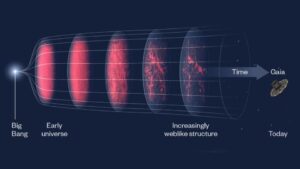
In trying to understand our universe, theorists can build models that describe how the universe formed as a mostly, but not completely, smooth distribution of matter and energy and how it evolved into a lacy pattern of galaxy clusters and large-scale structures like walls of galaxies.
These models are great, and we’ve seen bits and pieces of observational evidence that support them. What we haven’t seen is a clear map of a large contiguous volume — at least not until now.
In a new paper, researchers using the Gaia space telescope present an all-sky survey of the location of over one million quasars. The most distant ones are shining at us from when the universe was just 1.5 billion years old. In maps of distribution as a function of time, it’s possible to see two things: the most distant galaxies are more smoothly distributed, and over time, the number of quasars decreases as they clump up in the sky and as they power down.
In that first situation, quasars are galaxies with actively feeding black holes in their cores, and that kind of behavior was much more common in the past. Over time, galaxies have used up their excess material by turning it into stars and through other processes, and they have also lost material to their environment as it is pushed out by light pressure or pulled out by gravity.
Second, this shows us how gravity allows areas that start with just the smallest amount of extra matter to attract more and more material toward them. This allows the slightly more dense to get significantly more dense while the less dense regions simply empty out.
The slow demise of quasars with time means we don’t get to see the local large-scale structure in high detail. To accomplish that, we have to use galaxies without active black holes, which means combining catalogs, and I’m sure that combination of data is in our future. For now, it’s just nice to see our long-held theories so clearly coming into focus in this largest volume survey so far completed.
This massive new catalog is published in The Astrophysical Journal with Kate Storey-Fisher as first author.
